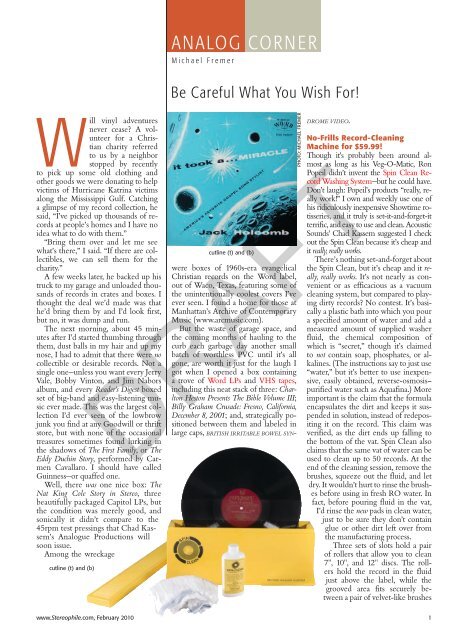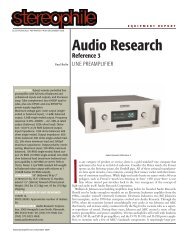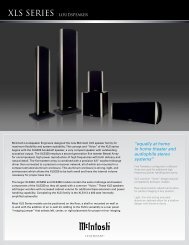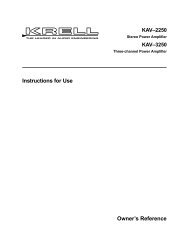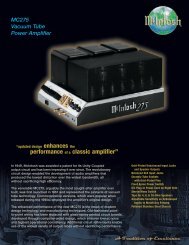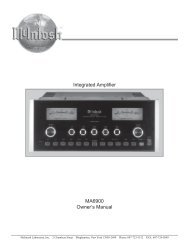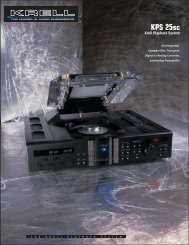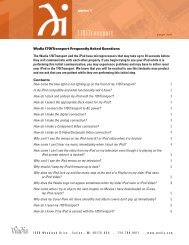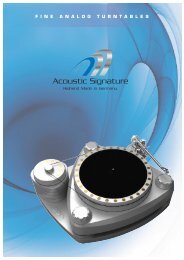Spin-Clean Stereophile Review - Music Direct
Spin-Clean Stereophile Review - Music Direct
Spin-Clean Stereophile Review - Music Direct
Create successful ePaper yourself
Turn your PDF publications into a flip-book with our unique Google optimized e-Paper software.
ANALOG CORNER<br />
Michael Fremer<br />
Be Careful What You Wish For!<br />
Will vinyl adventures<br />
never cease? A volunteer<br />
for a Christian<br />
charity referred<br />
to us by a neighbor<br />
stopped by recently<br />
to pick up some old clothing and<br />
other goods we were donating to help<br />
victims of Hurricane Katrina victims<br />
along the Mississippi Gulf. Catching<br />
a glimpse of my record collection, he<br />
said, “I’ve picked up thousands of records<br />
at people’s homes and I have no<br />
idea what to do with them.”<br />
“Bring them over and let me see<br />
what’s there,” I said. “If there are collectibles,<br />
we can sell them for the<br />
charity.”<br />
A few weeks later, he backed up his<br />
truck to my garage and unloaded thousands<br />
of records in crates and boxes. I<br />
thought the deal we’d made was that<br />
he’d bring them by and I’d look first,<br />
but no, it was dump and run.<br />
The next morning, about 45 minutes<br />
after I’d started thumbing through<br />
them, dust balls in my hair and up my<br />
nose, I had to admit that there were no<br />
collectible or desirable records. Not a<br />
single one—unless you want every Jerry<br />
Vale, Bobby Vinton, and Jim Nabors<br />
album, and every Reader’s Digest boxed<br />
set of big-band and easy-listening music<br />
ever made. This was the largest collection<br />
I’d ever seen of the lowbrow<br />
junk you find at any Goodwill or thrift<br />
store, but with none of the occasional<br />
treasures sometimes found lurking in<br />
the shadows of The First Family, or The<br />
Eddy Duchin Story, performed by Carmen<br />
Cavallaro. I should have called<br />
Guinness—or quaffed one.<br />
Well, there was one nice box: The<br />
Nat King Cole Story in Stereo, three<br />
beautifully packaged Capitol LPs, but<br />
the condition was merely good, and<br />
sonically it didn’t compare to the<br />
45rpm test pressings that Chad Kassem’s<br />
Analogue Productions will<br />
soon issue.<br />
Among the wreckage<br />
cutline (t) and (b)<br />
cutline (t) and (b)<br />
were boxes of 1960s-era evangelical<br />
Christian records on the Word label,<br />
out of Waco, Texas, featuring some of<br />
the unintentionally coolest covers I’ve<br />
ever seen. I found a home for those at<br />
Manhattan’s Archive of Contemporary<br />
<strong>Music</strong> (www.arcmusic.com).<br />
But the waste of garage space, and<br />
the coming months of hauling to the<br />
curb each garbage day another small<br />
batch of worthless PVC until it’s all<br />
gone, are worth it just for the laugh I<br />
got when I opened a box containing<br />
a trove of Word LPs and VHS tapes,<br />
including this neat stack of three: Charlton<br />
Heston Presents The Bible Volume III;<br />
Billy Graham Crusade: Fresno, California,<br />
December 8, 2001; and, strategically positioned<br />
between them and labeled in<br />
large caps, b r i t i s h i r r i ta b l e b o w e l s y n-<br />
d r o m e v i d e o.<br />
No-Frills Record-<strong>Clean</strong>ing<br />
Machine for $59.99!<br />
Though it’s probably been around almost<br />
as long as his Veg-O-Matic, Ron<br />
Popeil didn’t invent the <strong>Spin</strong> <strong>Clean</strong> Record<br />
Washing System—but he could have.<br />
Don’t laugh: Popeil’s products “really, really<br />
work!” I own and weekly use one of<br />
his ridiculously inexpensive Showtime rotisseries,<br />
and it truly is set-it-and-forget-it<br />
terrific, and easy to use and clean. Acoustic<br />
Sounds’ Chad Kassem suggested I check<br />
out the <strong>Spin</strong> <strong>Clean</strong> because it’s cheap and<br />
it really, really works.<br />
There’s nothing set-and-forget about<br />
the <strong>Spin</strong> <strong>Clean</strong>, but it’s cheap and it really,<br />
really works. It’s not nearly as convenient<br />
or as efficacious as a vacuum<br />
cleaning system, but compared to playing<br />
dirty records? No contest. It’s basically<br />
a plastic bath into which you pour<br />
a specified amount of water and add a<br />
measured amount of supplied washer<br />
fluid, the chemical composition of<br />
which is “secret,” though it’s claimed<br />
to not contain soap, phosphates, or alkalines.<br />
(The instructions say to just use<br />
“water,” but it’s better to use inexpensive,<br />
easily obtained, reverse-osmosis–<br />
purified water such as Aquafina.) More<br />
important is the claim that the formula<br />
encapsulates the dirt and keeps it suspended<br />
in solution, instead of redepositing<br />
it on the record. This claim was<br />
verified, as the dirt ends up falling to<br />
the bottom of the vat. <strong>Spin</strong> <strong>Clean</strong> also<br />
claims that the same vat of water can be<br />
used to clean up to 50 records. At the<br />
end of the cleaning session, remove the<br />
brushes, squeeze out the fluid, and let<br />
dry. It wouldn’t hurt to rinse the brushes<br />
before using in fresh RO water. In<br />
fact, before pouring fluid in the vat,<br />
I’d rinse the new pads in clean water,<br />
just to be sure they don’t contain<br />
glue or other dirt left over from<br />
the manufacturing process.<br />
Three sets of slots hold a pair<br />
of rollers that allow you to clean<br />
7", 10", and 12" discs. The rollers<br />
hold the record in the fluid<br />
just above the label, while the<br />
grooved area fits securely between<br />
a pair of velvet-like brushes<br />
DRAFT<br />
Photo: Michael Fremer<br />
www.<strong>Stereophile</strong>.com, February 2010 1
ANALOG CORNER<br />
that clean both sides simultaneously.<br />
Your job is to rotate the record with<br />
your open palm, contacting only the<br />
edge. Rotate the disc three or so times,<br />
then carefully remove it, let the excess<br />
fluid drain off into the vat, then dry<br />
the LP with one of the supplied soft,<br />
cheesecloth-like wipes (you can wash<br />
these, but don’t use fabric softener). It’s<br />
not the drying that removes dirt and<br />
fingerprints—the brushes and fluid do<br />
the work, so you won’t be rubbing dirt<br />
in again as you dry.<br />
It takes but a few minutes to spinwash<br />
and dry a record. You have to be<br />
careful to not lose patience and press<br />
too heavily with the cloth in hopes<br />
that you’ll dry the record faster—you<br />
won’t. The cloths become saturated<br />
after a few records, so make sure you<br />
have extras on hand if you plan to clean<br />
many records in one session. But trust<br />
me: You’ll quickly tire of the routine,<br />
so don’t expect to clean more than a<br />
handful at a time unless you’re a glutton<br />
for punishment.<br />
While <strong>Spin</strong> <strong>Clean</strong> claims you can<br />
clean up to 50 records per vat of fluid,<br />
I suggest playing it safe and refreshing<br />
the vat more often. The fluid is relatively<br />
inexpensive. $59.99 gets you the<br />
machine, brushes, rollers, and a 4-oz<br />
bottle of concentrated fluid—enough<br />
to fill the vat 14 times, or to clean 700<br />
LPs. A 16-oz bottle of fluid costs $20,<br />
the washable drying cloths $10 for a<br />
package of five.<br />
The <strong>Spin</strong> <strong>Clean</strong> worked very well. I<br />
cleaned some dirty, fingerprint-encrusted<br />
records, and when I removed them<br />
from the vat, all dirt and fingerprints<br />
were gone. Drying with the cloths isn’t<br />
the most convenient method, but not<br />
everyone wants to spend hundreds of<br />
bucks on a vacuum machine, and the<br />
<strong>Spin</strong> <strong>Clean</strong> got the job done. Just don’t<br />
tempt fate and clean too many records<br />
before changing the fluid or cleaning<br />
the brushes.<br />
Thanks, Chad! And now for something<br />
much more expensive . . .<br />
Concert Fidelity SPA-4B Phono<br />
Equalizer: $14,000<br />
Some audiophiles feel that if they’re<br />
spending a lot of money on something,<br />
they want it to be packed with a lot of<br />
stuff. Others feel that less is more, and<br />
DRAFT<br />
are willing to pay for the editing work<br />
that goes into providing less: shorter<br />
circuit paths, and fewer components<br />
that accomplish all that more complex<br />
designs can—and perhaps more.<br />
Both approaches can yield exceptional<br />
results, as proven by Jeff Nelson’s<br />
stuff-heavy Boulder 2008 phono preamplifier,<br />
and Peter Mares’ elegant and<br />
deceptively simple Connoisseur phono<br />
preamp, whose chassis is nearly empty.<br />
(Lyra’s Jonathan Carr now builds a new<br />
version of the Connoisseur using design<br />
principles drawn from Mares’ work.)<br />
Silicon Arts Design & Concert Fidelity’s<br />
resident audio purist, Masataka<br />
Tsudo, has been building tube and<br />
solid-state electronics for more than<br />
30 years in Nagano, a region known as<br />
“the Switzerland of Japan” for its meticulous<br />
manufacturing. He designed<br />
this solid-state moving-magnet/moving-coil<br />
phono preamp as he’s designed<br />
all of his other products, basing it on<br />
the philosophy of less is more. Their<br />
website states: “Our designs implement<br />
our unique <strong>Direct</strong> Signal Path<br />
Technology (DSPT), which follows<br />
Einstein’s maxim that things should be<br />
2 www.<strong>Stereophile</strong>.com, February 2010
ANALOG CORNER<br />
made as simple as possible but no simpler!”<br />
When you look inside, don’t be<br />
surprised to find a lot of empty space,<br />
with all essential signal-path circuitry<br />
hugging the rear of the chassis, near the<br />
input and output jacks. Tsudo has kept<br />
these signal paths extremely short: the<br />
leads of the input and output jacks are<br />
soldered directly to the circuit board.<br />
Tsudo chose his components on the<br />
basis of their sound quality, and, like the<br />
legendary Mares, conceived and built<br />
the circuit not on a flat board but threedimensionally—although,<br />
unlike the<br />
tiny, impossibly tangled maze inside the<br />
Connoisseur, the SPA-4B has two circuit<br />
boards, as well as custom-designed<br />
and -built power transformers.<br />
The SPA-4B features three class-A<br />
push-pull stages based on J-FETs, the<br />
first an MC head amp capable of providing<br />
20–30dB of gain, depending on<br />
the modules inserted into the multipin<br />
connectors on the rear-mounted board.<br />
The second and third stages provide a<br />
total of 40dB of gain with no negative<br />
feedback applied, but RIAA equalization<br />
applied between them. Tsudo’s<br />
design puts the loading resistors in<br />
series with the cartridge, which is unusual.<br />
Most load the cartridge output in<br />
parallel, whether via DIP switches or<br />
plug-in resistors. Take the resistors out<br />
and you still get a signal, usually with a<br />
default load of 47k ohms.<br />
Masataka Tsudo believes the seriesresistor<br />
approach results in better linearity<br />
and avoids the energy loss he says<br />
parallel resistors produce. However,<br />
placing the resistors in series means<br />
the actual gain results from the ratio<br />
of the cartridge’s internal impedance<br />
to the sum of the impedances of the<br />
resistive load and first-stage negative<br />
cutline (t) and (b)<br />
feedback loop. Therefore, the design<br />
of the MC stage—which is intended<br />
for only MC cartridges of low internal<br />
impedance—features plug-in modules<br />
that simultaneously alter the gain and<br />
the load resistance. Tsudo prepares<br />
these modules for the specific cartridge<br />
or cartridges specified by the buyer,<br />
using circuit simulations based on the<br />
cartridge’s specifications of internal<br />
impedance and output voltage. However,<br />
since published specs and actual<br />
performance don’t always match, variations<br />
in the output level and internal<br />
impedance specs can profoundly affect<br />
DRAFT<br />
www.<strong>Stereophile</strong>.com, February 2010 3
ANALOG CORNER<br />
the sound.<br />
The SPA-4B’s rear panel has both<br />
fixed and variable outputs, as well as<br />
separate inputs for each, with rearmounted<br />
volume pots for the variables.<br />
There are also both MM and<br />
MC inputs.<br />
I was supplied with a variety of<br />
modules that provided 20 or 25dB<br />
of gain with loading impedances of<br />
30 and 50 ohms. Given the Lyra<br />
Titan’s 5.5 ohm internal impedance<br />
and 0.5mV output level, the<br />
20dB/30 ohm module should have<br />
been ideal. But that resulted in insufficient<br />
gain. I had to turn the volume<br />
up to where noise and hum became<br />
problems. I tried the 25dB module,<br />
with only marginally better results.<br />
There was no point trying the Ortofon<br />
A90, which outputs 0.27 mV<br />
and has a 4 ohm internal impedance,<br />
or the 0.3mV Transfiguration Orpheus<br />
L (currently under review), so I contacted<br />
the Concert Fidelity’s chief operating<br />
officer and vice-president of<br />
marketing, Nori Sayanagi, who lives<br />
one town over from me. He suggested<br />
that a 25dB/100 ohm module be sent<br />
in place of the supplied 20dB/30 ohm<br />
module, which, he said, “many people<br />
have found optimum with Lyra cartridges.”<br />
I inserted the 25dB/100 ohm<br />
module and did a lot of listening.<br />
But while there was more gain with<br />
the new module installed, there still<br />
wasn’t enough to completely overcome<br />
the residual noise and low-level hum<br />
that intruded during low-level musical<br />
passages. With most music it wasn’t<br />
usually audible, but still, it was difficult<br />
to believe that the SPA-4B was producing<br />
anywhere near 65dB of gain.<br />
In heavy rotation<br />
1) Neil Young, Official Release<br />
Series Discs 1–4, Reprise<br />
180gm LPs (4)<br />
2) Jim O’Rourke, The Visitor, Drag<br />
City LP<br />
3) Frank Sinatra and Sextet, Live<br />
in Paris, Reprise/Mobile Fidelity<br />
Sound Lab 180gm LP<br />
4) Sufjan Stevens, The Brooklyn<br />
Queens Expressway: Original<br />
Soundtrack, Asthmatic Kitty<br />
180gm LP<br />
5) Fuck Buttons, Tarot Sport, ATP<br />
180gm LPs (2)<br />
6) Nirvana, In Utero, Sub Pop/ORG<br />
180gm LP<br />
7) Nellie McKay, Normal as<br />
cutline (t) and (b)<br />
I tried a variety of shelf positions to<br />
make sure the hum wasn’t being generated<br />
externally. I changed interconnects,<br />
power cords, and line conditioners,<br />
and used a cheater AC plug, but<br />
the hum clearly wasn’t the product of<br />
a ground loop.<br />
The shame of the gain/noise problem<br />
was that, otherwise, the sound<br />
produced by the Concert Fidelity<br />
SPA-4B was exceptionally clean, open,<br />
well extended, superdetailed, fast, and<br />
delicate—just what you’d expect and<br />
demand from so costly a product. The<br />
transient speed and delicacy of the<br />
sound extended from top to bottom<br />
of the audioband. And as well as being<br />
well-extended and muscular, the bass<br />
was taut and exceedingly well defined.<br />
The SPA-4B’s transparency and<br />
freedom from grain and edginess were<br />
exceptional, especially given its airy,<br />
open top end. The midrange, though<br />
hardly lush, was anything but lean.<br />
Massed orchestral strings had a lovely,<br />
natural sheen and plenty of textural<br />
detail. Classical guitar sounded absolutely<br />
mesmerizing. I could go on in<br />
greater specificity about the Concert<br />
Fidelity’s considerable virtues, especially<br />
its huge, open, airy soundstage,<br />
but the noise level was unacceptably<br />
high and too often became a distraction.<br />
If the SPA-4B had trouble<br />
with a 0.5mV signal, I don’t see how<br />
it can be suitable for cartridges of<br />
lower output.<br />
Nori Sayanagi did say that Concert<br />
Fidelity can provide modules<br />
offering 28 and 32dB of gain, and<br />
that the matching CF-080 LS hybrid<br />
line-stage preamp provides an<br />
additional 12dB of gain (switchable<br />
to 18dB in future versions) and, when<br />
used with the SP-A4B, can produce<br />
enough gain for Lyra cartridges.<br />
I’d say, then, that the SPA-4B is<br />
probably best used with Concert Fidelity’s<br />
own preamp, but that using it with<br />
other preamps is questionable. Certainly<br />
the darTZeel NHB-18NS preamplifier<br />
has enough gain, is exceptionally<br />
quiet, and has proven itself compatible<br />
with a wide range of phono preamps.<br />
Concert Fidelity has a less purist, more<br />
widely compatible phono preamp in<br />
the works. If it can combine 80% of<br />
the SPA-4B’s magic with a more acceptable<br />
signal/noise ratio, sufficient<br />
gain, and a lower price, well, I’ll be all<br />
for listening to that!<br />
Meanwhile, here’s another purist<br />
phono preamp, but for a lot less money<br />
. . .<br />
Sutherland Engineering<br />
The Hubble: $3800<br />
Ron Logan Sutherland has been designing<br />
phono preamps for decades, starting<br />
at least as far back as when analog<br />
died, and probably even earlier. Before<br />
that he was involved with electrostatic<br />
loudspeakers. (He was the “Logan” in<br />
MartinLogan.) The Hubble is his latest<br />
and, he thinks, best overall phono<br />
preamp.<br />
Like previous Sutherlands, the Hubble<br />
is battery-powered: 16 alkalines<br />
charge two banks of 16 1200µF capacitors<br />
each, for a total of 19,200µF per<br />
channel. The power source is located<br />
very close to the amplification circuitry,<br />
which appears to be op-amp based.<br />
Sutherland claims that a set of batteries<br />
provide 1000 hours of service. At $2.99<br />
per D-cell battery, each thousand hours<br />
of use costs at most $40, and considerably<br />
less if you buy batteries in bulk.<br />
Considering the price of a really topquality<br />
AC cord added to the price of<br />
a good AC-powered phono preamp,<br />
DRAFT<br />
Blueberry Pie: A Tribute to<br />
Doris Day, Verve 180gm LP<br />
8) The Rolling Stones, Get Yer<br />
Ya-Ya’s Out! The Rolling Stones<br />
in Concert—40th Anniversary<br />
Deluxe Boxed Set, ABKCO LPs<br />
(2), CDs (3), DVD-V (1)<br />
9) Califone, All My Friends Are<br />
Funeral Singers, Dead Oceans<br />
LPs (2)<br />
10) Blood, Sweat & Tears, Child Is<br />
Father to the Man, Columbia/<br />
Sundazed 150gm LP<br />
Visit www.musicangle.com for full<br />
reviews.<br />
Photo: Michael Fremer<br />
www.<strong>Stereophile</strong>.com, February 2010 5
ANALOG CORNER<br />
you’d have to log something like<br />
100,000 hours on the Hubble before<br />
the batteries would cost you anything<br />
at all. (Okay, that’s a convoluted way<br />
of approaching battery cost, but I like<br />
it, and I’m in charge here!)<br />
If you’re worried about accidentally<br />
leaving the Hubble on and blowing<br />
through $40 worth of batteries faster<br />
than you can say “Pomegranate Margarita,”<br />
don’t be. Sutherland has come<br />
up with a neat workaround for your<br />
senior moments and drunken/stoned<br />
stupors: Each rightward toggle of the<br />
control switch adds an hour of run<br />
time, as monitored by a serious of yellow<br />
LEDs. The most you can waste is<br />
four hours. Toggle the other way to<br />
turn off. When the LED blinks, you<br />
have—well, the Hubble has—10 minutes<br />
left.<br />
The Hubble is pure dual-mono<br />
from input to output—purer than<br />
some others, Sutherland says, in that it<br />
uses two identical circuit boards containing<br />
everything, whereas some dualmono<br />
designs have, for each channel,<br />
circuits that are electrically identical but<br />
laid out differently for reasons of cost<br />
and/or convenience. The Hubble’s two<br />
channels share only the power-control<br />
circuit board, batteries, and substantial<br />
chassis.<br />
Sutherland keeps configurability<br />
both versatile and closely held, with<br />
pairs of gold-plated sockets for each<br />
channel located directly adjacent to<br />
the signal paths. Four options of gain<br />
(45, 50, 55, and 60dB) and six of loading<br />
(10k, 4.75k, 1k, 475, 200, and 100<br />
ohms) are contained on plug-in cards:<br />
two values per board. Inverting the<br />
boards switches between that board’s<br />
values. Leave the card bay empty and<br />
you have the Hubble’s default MM<br />
loading of 47.5k ohms. In addition,<br />
Contacts<br />
Silicon Arts Design & Concert<br />
Fidelity U.S., 351 E. Glen Ave.,<br />
Ridgewood, New Jersey 07450.<br />
Tel: (201) 444-3378. Web: www.<br />
concertfidelity.jp.<br />
<strong>Spin</strong> <strong>Clean</strong> Record Washing<br />
System, PO Box 15200, Pittsburgh,<br />
PA 15237-0200. Tel: (800) 931-<br />
5850. Web: www.spincleanrecord<br />
washer.com.<br />
Sutherland Engineering. Web:<br />
www.sutherlandengineering.com.<br />
DRAFT<br />
cutline (t) and (b)<br />
Sutherland provides a pair of blank<br />
cards so you can roll your own load impedance.<br />
The Hubble ships with a 100<br />
ohm load and 60dB gain installed.<br />
Remove eight knurled screws on the<br />
bottom plate, lift off the cover, install<br />
the batteries, and you’re good to go.<br />
Leaving the cover off doesn’t expose<br />
dangerous voltages, which makes experimenting<br />
with loading and gain<br />
easier and more convenient.<br />
The Hubble was very quiet. <strong>Music</strong><br />
poured forth from jet-black backgrounds.<br />
This is hardly surprising with<br />
battery power, though if a component’s<br />
solid-state devices are noisy, you’ll hear<br />
noise. The Hubble’s were relatively<br />
quiet.<br />
The Sutherland house sound has<br />
always been on the warm, rich side<br />
to my ears, and the Hubble was no<br />
exception—but it was more on the neutral,<br />
more exuberant side of warm than<br />
what I remember of the other Sutherlands<br />
I’ve heard. The top end, while<br />
not exactly wide open, was pleasingly<br />
so, giving cymbals a welcome amount<br />
of shimmer and air, though never the<br />
last word in either department, regardless<br />
of loading. But turn up ORG’s<br />
sonically ideal new 180gm pressing of<br />
Nirvana’s In Utero (LP, Sub Pop/ORG)<br />
and listen to it through the Hubble and<br />
you won’t worry that you’re missing<br />
anything from the drum kit and guitars—<br />
even though there is, ultimately, more<br />
to be had.<br />
However, thanks to its fully developed<br />
and weighty bottom end, where<br />
the Hubble really excelled was in instrumental<br />
body and textures. Horns were<br />
meaty and harmonically fully fleshed<br />
out, toms and kick drums throbbed,<br />
pianos had woody sounding boards,<br />
and singers exhibited life below their<br />
necks. Add to the considerable weight<br />
macrodynamic exuberance and robust<br />
bass definition and punch and you have<br />
a strong foundation on which to build<br />
a big, stable sonic picture—which the<br />
Hubble did with considerable gusto.<br />
The Hubble’s basic tonality was rich,<br />
lush, generous, and not at all “solidstate<br />
sounding,” as detractors like to call<br />
transistor sound. My only quibble was<br />
with the somewhat reticent-sounding<br />
very top, which limited the full development<br />
of cymbal shimmer and flute<br />
air, etc., though how this will play out<br />
in your listening will depend on your<br />
system, cartridge, and preferences.<br />
High-frequency attacks were reasonably<br />
fast and clean, but the sustain<br />
of musical sounds seemed somewhat<br />
stingy and overdamped, failing to linger<br />
as long as it could have. This might<br />
account for both the Hubble’s high organization<br />
skills and its slight deficit of<br />
air and shimmer—and I was using the<br />
Lyra Titan i cartridge, which is hardly<br />
reserved on top; the Ortofon A90,<br />
which is about as neutral as they get;<br />
and the Transfiguration Orpheus L,<br />
about which I can’t say because that’s<br />
next time.<br />
While it isn’t cheap, the Sutherland<br />
Engineering Hubble is a worthwhile<br />
contender at $3800 and even beyond.<br />
It’s Ron Sutherland’s best, most balanced<br />
effort, and will prove an ideal fit<br />
in many systems—but not in ones already<br />
lurking at the dark end of Sound<br />
Street.<br />
nn<br />
www.<strong>Stereophile</strong>.com, February 2010 7


